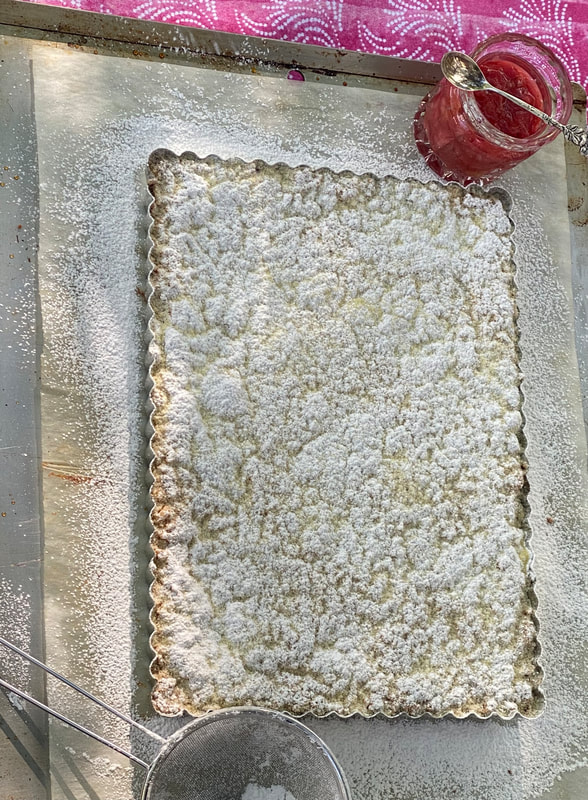|
Rhubarb and I have reached a bit of an impasse, and it’s not even Memorial Day.
Giddy with the not-so-novel idea of an upside down cake featuring stalks of pie plant, I hold up a photo. Rhubarb sighs. “What’s the problem? This is a stunning bake!” Totally nonplussed, Rhubarb shrugs his poisonous leaves and dismisses my upside down cake dream. The harbinger of spring then poses the obvious question, “Can’t you simply leave upside down cake to Pineapple? Why must you drag me into the mix?” Setting down a parchment-lined springform pan, I cajole. “C’mon… you know you’re perfectly suited to this role. You’ll love this cake- it’s spiked with ginger and healthy from yogurt, and of course…” I point in his direction. “What’s not to love?” Rhubarb pauses before replying. “What’s not to love is being subjected to a poaching syrup of hot caramel. What’s not to love is being wedged into the confines of a pan held together with a massive latch and then being smothered in cake batter. Call me petty, but withstanding fifty minutes of moderate heat under glaring lights before someone flips you on your head isn’t a pie plant’s dream. We’re a common garden vegetable, for crying out loud, not Cirque du Soleil!” Rhubarb continues. “Once again, you’re only thinking of yourself. Your breakfast slice, your post running snack, your dessert. Have you ever considered my feelings?” I hadn’t. Rhubarb lashes out, “You try standing on your head in a 9” springform pan with nowhere to turn.” Rhubarb is right, after all. It’s not easy coaxing lightly poached stalks of a spring vegetable into a tightly confined space. Refusing to line up with precision, the vegetable wiggles and rolls over, refusing to surrender to the blade of a small paring knife, overlapping in the wrong places and leaving unsightly gaps where the pan bottom meets the side. My fingers are scorched from the caramel syrup and unlike the photograph, the brilliant pink stalks are less brilliant post-bake. Still, the cake bakes up perfectly tart from the rhubarb and spicy from the candied ginger and just sweet enough from the caramel. I have a slice for breakfast and another later in the afternoon. And despite the hullaballoo from the star ingredient, I’d call this Ottolenghi recipe a wild success.
1 Comment
Jam-filled shortbread knows many variations. Perhaps the most popular is Hungarian shortbread, a match made in cholesterol heaven, with plenty of butter cozying up to sugar, flour, and sunny egg yolks. Julia Child is credited with the recipe and so is Gale Gand and Dorie Greenspan. Czech cookbooks dub the cookie omlos teasutemeny, roughly translated into ‘short pastry biscuit.’ South African cookbooks share a similar shortbread recipe and plenty of Jewish grandmothers baked a version, adding ground walnuts to the mix because they couldn’t leave well enough alone. My friend Jane DeAngelo who lived to be 100, made an Italian version she called Biscotti con Marmellata. Some recipes called for hard boiled egg yolks, but Jane used yolks directly out of the shell, flavoring the dough with just a hint of vanilla or almond extract. Once the dough was mixed and then frozen, Jane subjected the dough to a box grater, letting the shards fall into a rimmed cookie sheet. The next layer was jam, sometimes apricot, sometimes raspberry, followed by another layer of grated dough. Hot out of the oven, the bar cookies received a liberal dousing of confectioners’ sugar. I vividly remember Jane’s knack for cutting the bars into perfectly identical, slender, rectangular fingers without benefit of a ruler. Gliding a thin bladed knife through the hot tray, the fluffy crumbs of shortbread would shatter, sending tiny wisps of powdered sugar into the air.
I encountered two roadblocks on my way to Hungarian shortbread nirvana this week. The first was the dreaded ‘pan conversion.’ Despite more than enough resources available for guidance, I fumbled through my kitchen cabinet, stacking an assortment of square and rectangular pans on the counter. An entire pound of butter seemed awfully excessive for a mid-week bake, and half of a recipe seemed overly generous for two people. I didn’t want to use a springform pan, and I didn’t want to line anything with slings of parchment paper. Sorting through a stack of tart pans felt promising, unearthing a long forgotten fluted rectangular pan measuring eight inches by eleven. The shortbread dough filled the pan generously but without excess, negating any reason to steal a glance at that damn pan conversion chart. My Hungarian shortbread experience was far from flawless, however. In the final moments, just after retrieving the hot pan from the oven, I set it down on a level, heat-proof surface. Carefully filling a fine mesh strainer with an avalanche of powdered sugar, I promptly bumped the strainer on the edge of the counter, watching in slow motion horror as the indelibly white sugar blanketed my very navy blue shirt, sweats, and sneakers. |
Archives
July 2024
Ellen GrayProfessional Pie-isms & Seasonal Sarcasm Categories |


 RSS Feed
RSS Feed